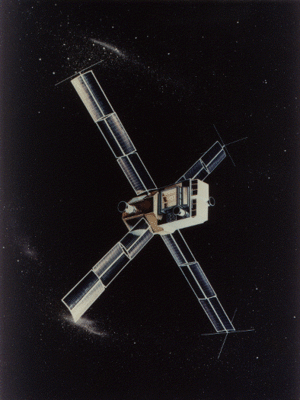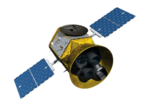Astronomy:Explorer 53
 Explorer 53 satellite | |
| Names | SAS-C SAS-3 Small Astronomy Satellite-3 |
|---|---|
| Mission type | X-ray astronomy |
| Operator | NASA |
| COSPAR ID | 1975-037A |
| SATCAT no. | 07788 |
| Mission duration | 12 months (planned) 4 years (achieved) |
| Spacecraft properties | |
| Spacecraft | Explorer LIII |
| Spacecraft type | Small Astronomy Satellite |
| Bus | SAS |
| Manufacturer | Goddard Space Flight Center |
| Launch mass | 196.7 kg (434 lb) |
| Dimensions | 470.3 cm (185.2 in) tip-to-tip and 145.2 cm (57.2 in) high |
| Power | 65 watts |
| Start of mission | |
| Launch date | 7 May 1975, 22:45:01 UTC |
| Rocket | Scout F-1 (S-194C) |
| Launch site | Broglio Space Center, San Marco platform |
| Contractor | Vought |
| Entered service | 7 May 1975 |
| End of mission | |
| Decay date | 9 April 1979 |
| Orbital parameters | |
| Reference system | Geocentric orbit[1] |
| Regime | Low Earth orbit |
| Perigee altitude | 509 km (316 mi) |
| Apogee altitude | 516 km (321 mi) |
| Inclination | 3.00° |
| Period | 94.90 minutes |
| Instruments | |
| Extragalactic Experiment (EGE) Galactic Absorption Experiment (GAE) Galactic Monitor Experiment (GME) Scorpio Monitor Experiment (SME) | |
Explorer program | |
Explorer 53 was a satellite launched specifically for the purpose of X-ray astronomy of the NASA. It was also known as the SAS-C (for Small Astronomy Satellite-C, being third of the three-spacecraft SAS series), SAS-3.[2]
Mission
Explorer 53 (SAS-C) was a small spacecraft whose objectives were to survey the celestial sphere for sources radiating in the X-ray, gamma ray, ultraviolet, and other spectral regions. The primary missions of Explorer 53 were to measure the X-ray emission of discrete extragalactic sources, to monitor the intensity and spectra of galactic X-ray sources from 0.2 to 60-keV, and to monitor the X-ray intensity of Scorpio X-1.[2]
Launch
The spacecraft was launched from the San Marco platform off the coast of Kenya, Africa, into a near-circular, equatorial orbit. This spacecraft contained four instruments: the Extragalactic Experiment, the Galactic Monitor Experiment, the Scorpio Monitor Experiment, and the Galactic Absorption Experiment. In the orbital configuration, the spacecraft was 145.2 cm (57.2 in) high and the tip-to-tip dimension was 470.3 cm (185.2 in). Four solar paddles were used in conjunction with a 12-cell nickel–cadmium battery to provide power over the entire orbit. The spacecraft was stabilized along the Z-axis and rotated at about 0.1°/seconds. Changes to the spin-axis orientation were by ground command, either delayed or in real time. The spacecraft could be made to move back and forth ± 2.5° across a selected source along the X-axis at 0.01°/seconds. The experiments looked along the Z-axis of the spacecraft, perpendicular to it, and at an angle.[1]
Experiments
Extragalactic Experiment (EGE)
This experiment determined the positions of very weak extragalactic X-ray sources. The instrument viewed a 100-sq degree region of the sky around the direction of the spin axis of the satellite. The nominal targets for a 1-year study were: (1) the Virgo Cluster of galaxies for 4 months, (2) the galactic equator for 2 months, (3) the Andromeda Nebula for 3 months, and (4) the Magellanic Clouds for 3 months. The instrumentation consisted of one 2.5-arc-minutes and one 4.5-arc-minutes Full width at half maximum (FWHM) modulation collimator, as well as proportional counters sensitive over the energy range from 1.5 to 10-keV. The effective area of each collimator was about 225-cm2. The aspect system provided information on the orientation of the collimators to an accuracy of 15-arc-seconds.[3]
Galactic Absorption Experiment (GAE)
The density and distribution of interstellar matter was determined by measuring the variation in the intensity of the low-energy diffuse X-ray background as a function of galactic latitude. A 1-micrometer polypropylene window proportional counter was used for the 0.1- to 0.4-keV and 0.4- to 1.0-keV energy ranges, while a 2-micrometer titanium window counter covered the energy range from 0.3 to 0.5 keV. In addition, two 1-mm beryllium window counters were used for the 1.0- to 10-keV energy range. The collimators in this experiment had fields of view of 3° for the 1-micrometer counter, 2° for the 2-micrometer counter, and 2° for the 1-mm counters.[4]
Galactic Monitor Experiment (GME)
The objectives of this experiment were to locate galactic X-ray sources to 15 arc-seconds and to monitor these sources for intensity variations. The source positions were determined with the use of the modulation collimators of the Extragalactic Experiment during the nominal 2-month observation of the galactic equator. The monitoring of the X-ray sky was accomplished by the use of three slat collimators. One collimator, 1° by 70° FWHM, was oriented perpendicular to the equatorial plane of the satellite, while the other two, each 0.5° by 45° FWHM, were oriented 30° above and 30° below the first. The detector behind each collimator was a proportional counter, sensitive from 1.5 to 13-keV, with an effective area of about 100-cm2. The 1.0° collimator had an additional counter of the same area, sensitive from 8 to 50-keV. Three lines of position were obtained for any given source when the satellite was being spun at a steady rotation of 4 arc-minutes/seconds about the Z-axis.[5]
Scorpio Monitor Experiment (SME)
A 12° by 50° FWHM slat collimator was oriented with its long axis perpendicular to the satellite spin axis such that a given point on the sky could be monitored for about 25% of a rotation. This collimator was inclined by 31° with respect to the equatorial plane of the satellite, so that Scorpio X-1 was observed while the Z-axis was oriented to the Virgo Cluster of galaxies. The detectors used in this experiment were proportional counters with 1-mm beryllium windows. The energy range was from 1.0 to 60-keV, and the total effective area was about 40-cm2.[6]
See also
- Explorer 42
- Explorer 48
- Explorer program
References
- ↑ 1.0 1.1 "Trajectory: Explorer 53 (SAS-C) 1975-037A". NASA. 28 October 2021. https://nssdc.gsfc.nasa.gov/nmc/spacecraft/displayTrajectory.action?id=1975-037A.
 This article incorporates text from this source, which is in the public domain.
This article incorporates text from this source, which is in the public domain.
- ↑ 2.0 2.1 "Display: Explorer 53 (SAS-C) 1975-037A". NASA. 28 October 2021. https://nssdc.gsfc.nasa.gov/nmc/spacecraft/display.action?id=1975-037A.
 This article incorporates text from this source, which is in the public domain.
This article incorporates text from this source, which is in the public domain.
- ↑ "Experiment: Extragalactic Experiment (EGE)". NASA. 28 October 2021. https://nssdc.gsfc.nasa.gov/nmc/experiment/display.action?id=1975-037A-01.
 This article incorporates text from this source, which is in the public domain.
This article incorporates text from this source, which is in the public domain.
- ↑ "Experiment: Galactic Absorption Experiment (GAE)". NASA. 28 October 2021. https://nssdc.gsfc.nasa.gov/nmc/experiment/display.action?id=1975-037A-04.
 This article incorporates text from this source, which is in the public domain.
This article incorporates text from this source, which is in the public domain.
- ↑ "Experiment: Galactic Monitor Experiment (GME)". NASA. 28 October 2021. https://nssdc.gsfc.nasa.gov/nmc/experiment/display.action?id=1975-037A-02.
 This article incorporates text from this source, which is in the public domain.
This article incorporates text from this source, which is in the public domain.
- ↑ "Experiment: Scorpio Monitor Experiment (SME)". NASA. 28 October 2021. https://nssdc.gsfc.nasa.gov/nmc/experiment/display.action?id=1975-037A-03.
 This article incorporates text from this source, which is in the public domain.
This article incorporates text from this source, which is in the public domain.


